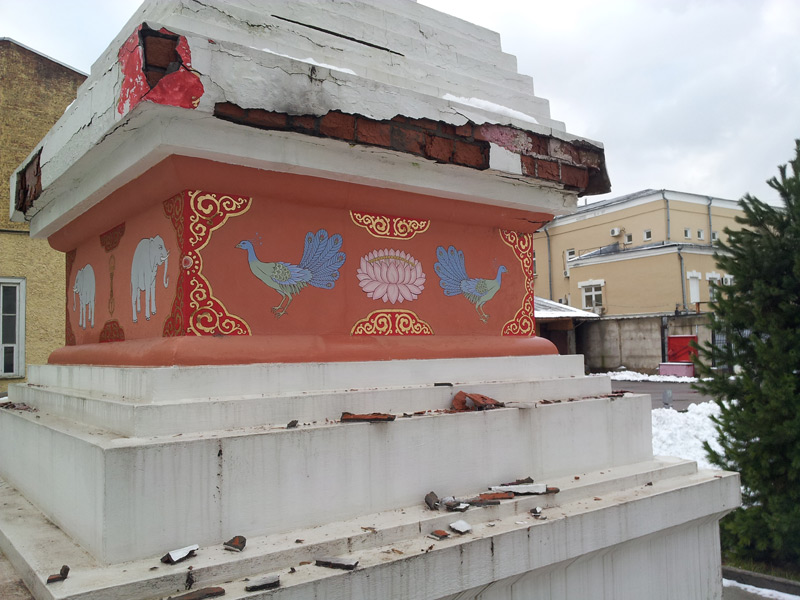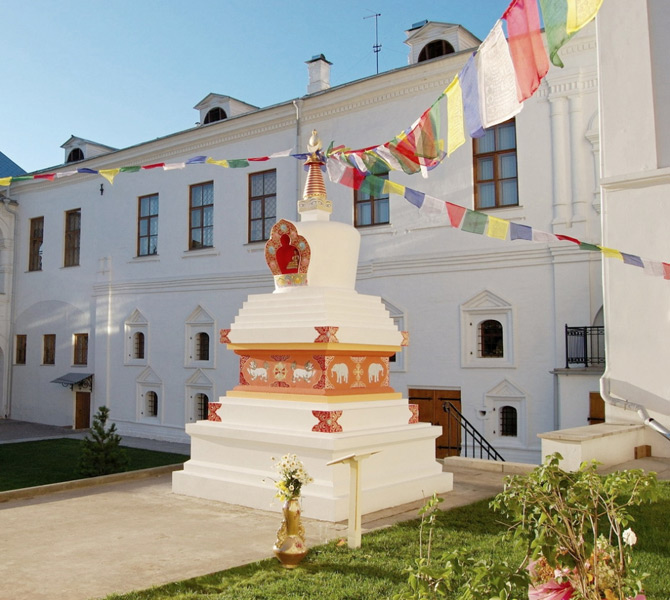A Buddhist stupa is dying in MoscowHow officials ignore the decisions of President Vladimir Putin The Moscow Buddhists are in despair. For a year now they have not been able to access the Buddhist stupa of the “Three Jewels”, which is located not far from the Kremlin on the territory of the old Lopukhins' estate in Maly Znamensky Lane. In 2017, on April 28, the estate was transferred to the State Museum of Oriental Art with the support of the Ministry of Culture. Recently, mass disappearances of cultural valuables, documents and personal belongings of employees of the Roerich Center, as well as deliberate damage of expensive museum equipment that costs many millions of rubles were revealed in the Lopukhins' estate which was transferred to the State Museum of Oriental Art for safekeeping. The once active life in the manor has almost frozen. Over and above, for almost 10 months, the cast-iron lattice gates of the Lopukhins' estate have been tightly closed to the bolts for visitors. Only some elected people have been allowed into the territory by special passes or by agreement with the authorities. The once open and public manor yard turned into a closed zone of especially strict regime in the very center of Moscow.
Among the victims are thousands of Buddhists. For many years they were attracted to the estate by a unique Buddhist Stupa of the Three Jewels. It was built by Buddhist lamas and donated in 2008 to the Roerich Museum of the International Centre of the Roerichs (the ICR) as a museum exhibit telling about the culture of the peoples of the East, to which the Roerichs dedicated their famous Central Asian expedition. By the way, the latter became the greatest achievement of Russian geographical science of the last century. Until 2017, the Stupa of the Three Jewels of the Lopukhins' estate was the only one of its kind in the capital of Russia, as Buddhist lamas created it according to all canonical rules. In addition, this stupa is rightfully a Buddhist shrine of Russia. During the construction, the relics of two hundred outstanding Buddhist teachers brought from all over the world were laid in it. Among them are the sacred relics of the Buddha Kashyapa and the Buddha Shakyamuni over two and a half thousand years old. Such an abundance of unique artifacts gave this place a special cultural and historical significance. Buddhists came daily from all over the world to bow down and just see the stupa. Among the visitors to the Lopukhins' estate were quite a few high Buddhist teachers representing various schools of Buddhism. For example, the Honorable Geshe Lhakdor, Director of the Library of Tibetan Works and Archives (the main center for the preservation of the Buddhist heritage of Tibet), the renowned spiritual Tibetan mentor the Honorable Katog Goetze Rinpoche, the Honorable Mahapandit Nangyal Ati Sherab Nyima Rinpoche, the official delegations of the largest Buddhist monastery-university Drepung Gomang (India), and Tibetan monasteries Goman Datsan and Jonang, as well as well-known scholars - Buddhism experts Glen Mullinn and Robert Thurman. In June 2016, the leadership of the Ministry of Culture of the Russian Federation and the State Museum of Oriental Art tried to present the Stupa of the Three Jewels as an illegal unauthorized construction, raising the question of its demolition. The spiritual leaders of the two Buddhist republics of Kalmykia and Tyva, Shadzhin-Lama Telo Tulku Rinpoche and Kamby-Lama Lopsan Chamzy, spoke in defense of the shrine against destruction. In an open letter, they asked President Vladimir Putin to assist the preservation of the unique cultural object. “For Buddhists in Russia and the whole world,” the statement said, “the destruction of a stupa with Buddha particles will become not only a personal tragedy, but also the greatest sin. We also ask you to save the non-governmental Museum named after N.K. Roerich in Moscow as a unique cultural and educational center, whose activities contribute to the development of tolerance, mutual understanding, peace and harmony in society.” It is reliably known that President Vladimir Putin gave personal instructions to Moscow Mayor S. Sobyanin and Culture Minister V. Medinsky not to touch Stupa, but, apparently, the officials interpreted the words of the head of state in their own way - it was said to leave only stupa, it means the Roerich Museum can be destroyed. And that was done. "Fulfilling" the decision of the president on the Stupa of the Three Jewels, state ranks left it literally in peace. Having received the Lopukhins' estate under its jurisdiction, the management of the State Museum of Oriental Art, without burdening themselves with answers to any requests and appeals about the need for urgent repair and restoration works, completely closed access to the stupa to its real owners – the representatives of the International Center of the Roerichs. The access is also denied for the Moscow Buddhists concerned about the current threatening situation. As a result, over the past year, a unique object without supervision and attention has come into a deplorable state. One gets the impression that the officials did not abandon their plans to demolish the Stupa of the Three Jewels. It was just that a less resonant for the public solution of this task was found - the silent mayhem of a unique construction by creating the conditions for its natural destruction. To hide the monstrous appearance of the stupa, the current owners of the Lopukhins' estate covered it from prying eyes with a hastily hammered sarcophagus, on the facade of which is a picture of a beautiful stupa in its original form of the times of 2008. At the same time, the Ministry of Culture of the Russian Federation keeps deathly silence, without interfering with the lawlessness perpetrated on the territory of the Lopukhins' estate. And in this deadly silence created by the indifference of the officials, a unique object of the highest spiritual and cultural significance for our people is slowly dying. The Stupa’s initial view Author: Alexander Smirnov
|
Copyright © 2008-2024 ST. PETERSBURG BRANCH OF THE INTERNATIONAL CENTER OF THE ROERICHS
Life and creative work of Nicholas Roerich | Exhibitions | Excursions | Scientific research | Protection of the Roerichs' name and heritage



